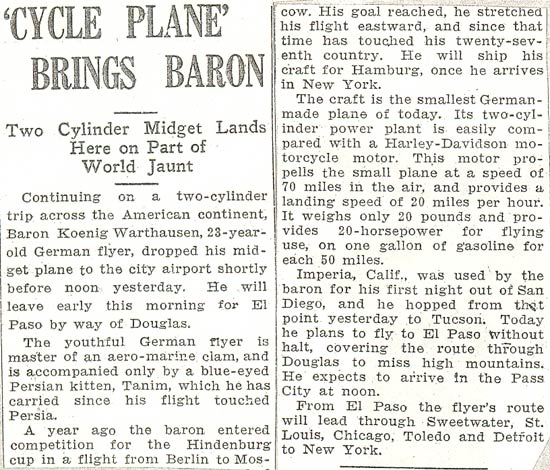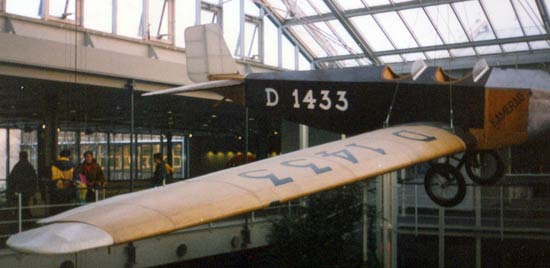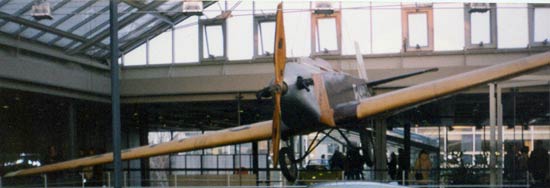|
THINK ABOUT IT!
You're 22 years old living in Germany during the late stages
of the Weimar Republic. Your well-to-do father buys you a small, very
light airplane (Klemm-Daimler D-1433).
You learn to fly (about 20 hours solo flight time). You decide
to compete for the "Hindenburg Cup" prize offered
by President Paul von Hindenburg to the amateur pilot completing
the best sporting flight of the year. You figure a flight
from Berlin to Moscow should clinch the cup.
Departing August 9, 1928 from Berlin you fly to Moscow,
win the cup, but decide to keep on going east. So, for the
next 16 months you live an adventure that few of us today
can even imagine. Over a year later (after accumulating
450 flight hours and traveling 20,000 miles), on November
22, 1929, you arrive back in Germany, having circumnavigated
the globe, west to east, solo, in a small airplane. IMPORTANT POINT: This was the first time anyone had ever flown around the world (for more information, please direct your browser to the links, left sidebar). And
so it was.
Now comes world traveler Friedrich Karl Freiherr Baron von Koenig-Warthausen
to our Airfield in Tucson. We see him in only a snapshot
near the end of his global itinerary.
In his book (reference, left), his approach to Tucson was
one like many contemporary pilots live through. He described
it as follows (pp. 152-53).
| "I had just crossed the Colorado River and was
flying over an Indian reservation [the Colorado River
Reservation?], when the weather changed suddenly, and
great drops of rain began to come down. On account of
the intense heat, even though I was not pleased at the
thought of getting wet, I welcomed this shower. The clouds
turned yellow and green and lightning appeared to be striking
from all sides, accompanied by rolls of terrific thunder.
I could see Tucson in the distance by this time, and was
determined to make it. I gave my motor all the gas it
would take, and as I was fairly high I could, by heading
down just a little bit, fly toward Tucson with great speed.
I reached the airport just in time. Scarcely had I nosed
my ship into the hangar, then everything turned black
and the storm broke loose with terrific fury. I stood
at one of the windows of the hangar's office looking out
at the downpour which raged with such force that I could
not see ten feet before me on account of the sand that
was being lifted high into the air." |
And so he landed at Tucson at 1:50PM on July 8, 1929, and
then departed the morning of the 9th at 8:00AM. His visit
is newsworthy, as the following clipping from July 9th Tucson
Star shows:
Ahem, well, as journalists sometimes do, they skipped the
copy editing and mulched the airplane name, calling it an
"aero-marine clam". They meant Aeromarine-Klemm,
even though this airplane was a Klemm-Daimler made in Germany,
not in the United States (by the Aeromarine-Klemm Corp., which
later manufactured them at Keyport, NJ). They got the cat's
name correct, however.
The next eight photographs are shared with us by friend of dmairfield.org, John Underwood. They capture von Warthausen and his airplane at different points during his flight. The first two photos (with captions) were snapped at Alameda, CA.
The Baron (R) With Wm. H. Royle, Alameda, CA, 1929 (Source: Underwood)
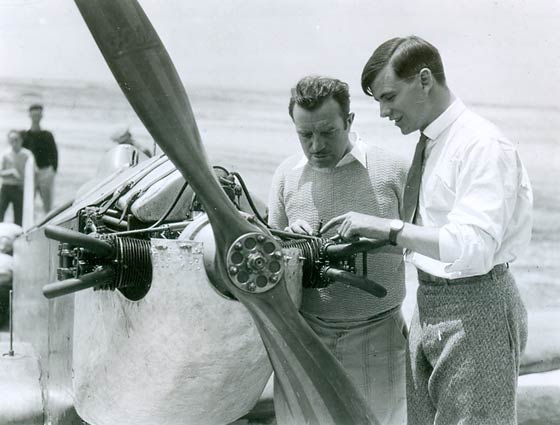 |
Below, the annotation on the back of this photograph.
Caption: The Baron (R) With Wm. H. Royle, Alameda, CA, 1929 (Source: Underwood)
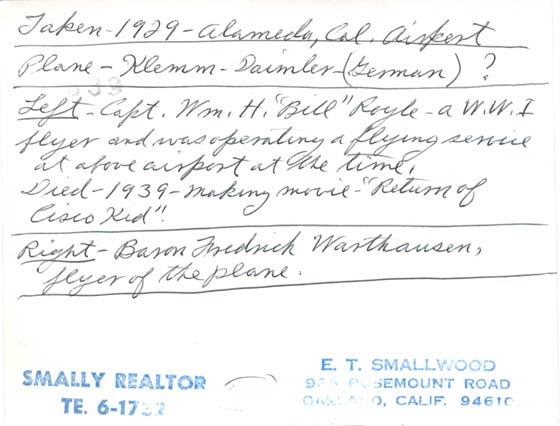 |
The Baron, Alameda, CA, 1929 (Source: Underwood)
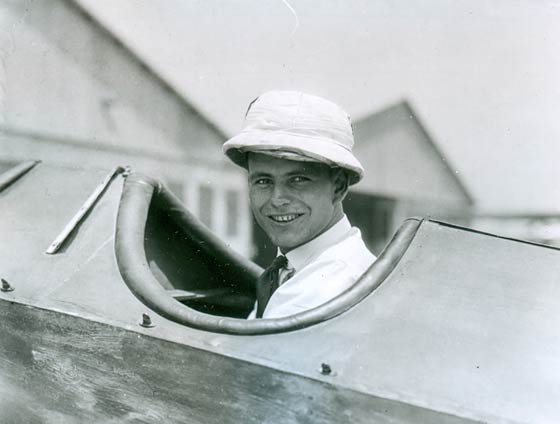 |
Caption: The Baron, Alameda, CA, 1929 (Source: Underwood)
 |
Below, the Baron with two unidentified gentlemen (although the one on the left looks like Register pilot Tommy Tomlinson).
The Baron (C) With Two Unidentified (Source: Underwood)
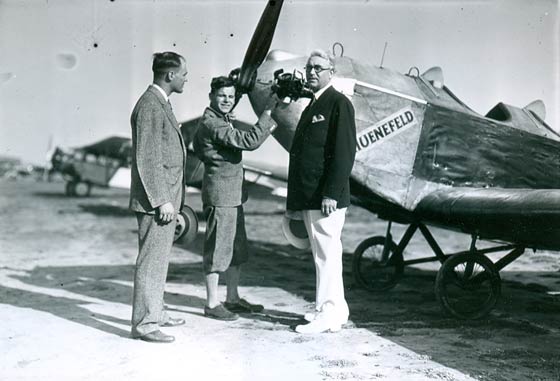 |
Below, a different view of the airplane and the same three people. Note the looseness of the fuselage fabric near the "14."
The Baron (C) With Two Unidentified (Source: Underwood)
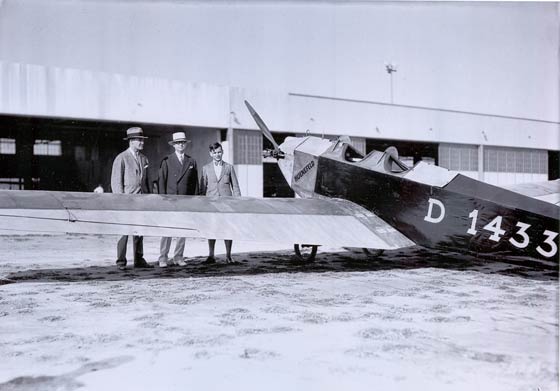 |
Below, at the end of his flight in New York.
The Baron at New York, November, 4,1929 (Source: Underwood)
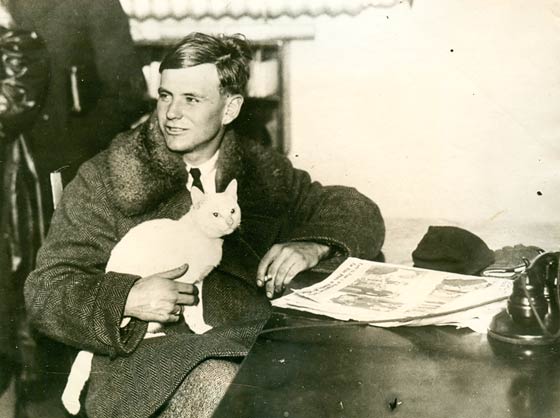 |
Caption: The Baron at New York, November, 4,1929 (Source: Underwood)
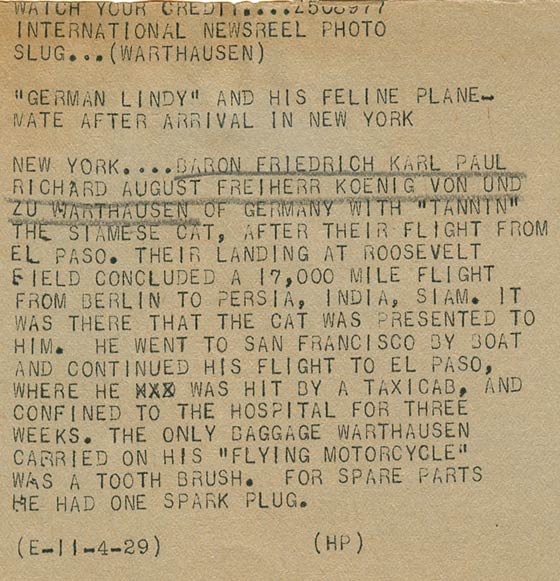 |
Just after he left Tucson his journey was rudely interrupted
at El Paso, TX. On July 12th, the taxicab driving Koenig-Warthausen
to the airport had a major accident and he woke up in hospital.
He spent about two months convalescing in El Paso. It is
during this forced stay that the 1929 National Air Races
passed through El Paso on August 21.
The 1929 cross-country race was the first in which women
were allowed to compete. Thea Rasche, a German pilot, was
among the female competitors. In Jessen's "The
Powder Puff Derby of 1929"
(reference, left), we find the author describing our pilot
Koenig-Warthausen:
| "An imposing figure paced the ramp, steadfast
in the mounting wind, awaiting Thea Rasche's arrival
in E. Paso. F.K. Baron von Koenig-Warthausen, taking
time from his world tour in a Klemm aircraft, had diverted
to Texas to encourage his fellow countryman. Unfortunately,
Thea was running a lap behind and did not pass through
El Paso until the next day. The Derby's managing director
tried to placate the German, speaking admiringly of
Thea and telling the Baron that she had exhibited rare
skills." pp. 140-41 |
Details aside regarding his reason for "taking time from
his world tour", the cat had been found in a tree unharmed
(eight lives left?), and they both continued their voyage
departing El Paso on September 15th.
He finished his flight across America in New York where
he sailed at midnight on November 15th on the Bremen to Germany,
where he docked on November 22nd. His next flight leg was
to take him from Bremer Haven to Berlin. However, fog and
rain forced him to make a landing in the vicinity of Hanover.
He went by automobile the rest of the way to Berlin for his
reception at Temple Hof Field. He was welcomed by officials
of the German Government, friends and his parents.
Over the
next two days he received another welcome at the German Aero
Club, and he was received by President von Hindenburg and
presented with the Hindenburg Cup he won
the year before. He then traveled to his father's castle
at Sommershausen in the south of Germany where he proceeded
to write his book cited in the left column (image, above, from his book). His was truly
a grand adventure!
---o0o---
ABOUT HIS AIRPLANE
The Airplane: Koenig-Warthausen's round-the-world
airplane is a Klemm L20B I, Serial or Werk Nummer 14, manufactured
in Germany. It carried German registration number D-1433.
It still exists today, as a partial replica, at the Daimler-Benz
Museum, Stuttgart (images below, used with permission of the
image owner).
The image, below left to right, shows the baron's father,
himself, his mother and his aircraft's manufacturer, Dr.
Hanns Klemm. For the era, his parents certainly allowed
and endured their son's long, long leash. They must have been very proud
of his accomplishment.
---o0o---
The Klemm Factory: About 1926, Dr. Hanns
Klemm founded the Leichtflugzeugbau Klemm (LFK) (Klemm Light
Aircraft) in Böblingen. Klemm was an important employer
in Böblingen. The number of employees grew from 50 in
1928 to 250 in 1933 and to about 900 employees in 1941. The
apprenticeship program at Klemm was considered exemplary.
The Klemm company earned the reputation of being very innovative
and commercially very successful. Hanns Klemm's vision was
to build aeroplanes which, like cars, would allow a much wider
circle of people to buy and run a plane. That meant a plane
which was easy to manufacture and cheap to maintain, and ideally
also fit in a garage. All development had to be subordinated
to this primary goal.
For this reason Klemm aircraft were not spectacular as far
as horsepower and speed are concerned, but they were spectacularly
economical and practical. Almost every flyer in Germany in
the 20's and 30's learned to fly in a Klemm. In 1932, production
reached 25 planes per month. Subsidiaries were formed abroad,
among other places in the USA, Great Britain, and Sweden.
In 1933 the National Socialists came to power in Germany
and Hanns Klemm too, swept up by the spirit of national
resurgence, joined the Nazi party in 1933. He soon became
overwhelmed with the demands of the party, which took away
control of his company. He quit the party and was severely
persecuted by the Gestapo into the 1940s.
---o0o---
Dossier 2.1.22
THIS PAGE UPLOADED: 01/11/06 REVISED: 01/14/06, 01/17/06, 02/10/06,
10/30/07, 03/15/10
|




